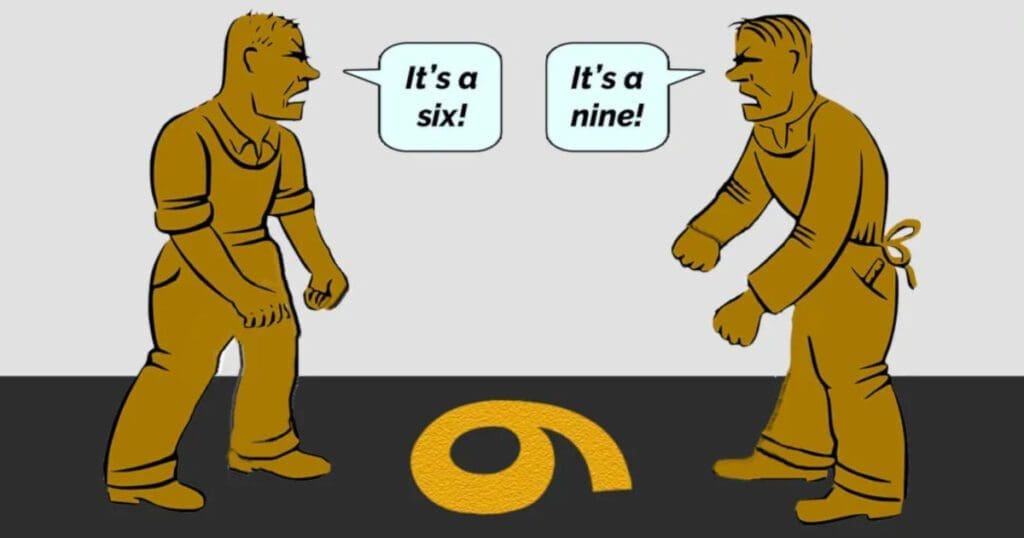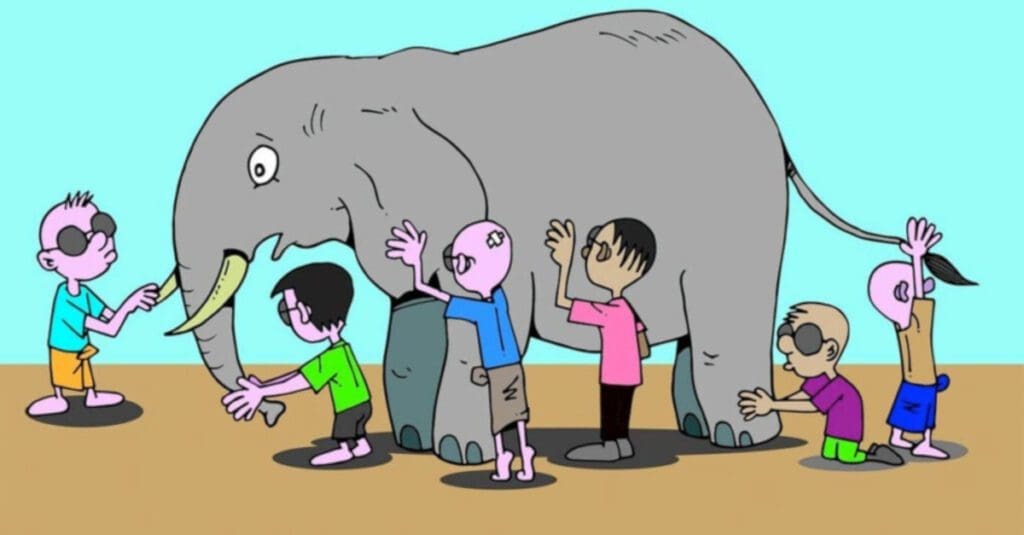Two images, in particular, remind me of the limitations of what I see. They are helping me be more humble when I think of my conversations with those who do not view things the way I do.
As certain as I am of what I believe in, what I see is not the whole story.

An ancient story turned into an image
A group of blind men heard that a strange animal, called an elephant, had been brought to the town, but none of them were aware of its shape and form. Out of curiosity, they said: “We must inspect and know it by touch, of which we are capable”. So, they sought it out, and when they found it they groped about it.
The first person, whose hand landed on the trunk, said “This being is like a thick snake”. For another one whose hand reached its ear, it seemed like a kind of fan. Another person, whose hand was upon its leg, said, the elephant is a pillar like a tree-trunk. The blind man who placed his hand upon its side said, “elephant is a wall”. Yet another who felt its tail, described it as a rope. The last felt its tusk, stating the elephant is that which is hard, smooth and like a spear.
Over the centuries the story has had different endings.

In some versions, the blind men discover their disagreements, suspect the others to be not telling the truth, and come to blows.
In other versions, they stop talking, start listening and collaborate to “see” the full elephant. Sometimes when a sighted man enters the parable and describes the entire elephant from various perspectives, the blind men then learn that they were all partially correct and partially wrong.
One’s subjective experience can be true. But it may not be the totality of truth.
Another humbling image…
This image speaks to me of the clash of mindsets… and ready to fight for what they see plainly with their own eyes

I encourage you to look at their certitude about proclaiming what they see. Can you understand? The problem is that while they were looking at the same reality, they were looking from two different vantage points.
Conflict among the early followers of Jesus
What I see in these speaks volumes about the conflicts in the early Church.
The book of Acts shows us the transition of the Christian movement from a largely Jewish context to a gospel which is universal, not only embracing the Gentiles but becoming a somewhat Gentile phenomenon. It begins in Jerusalem with a handful of Jewish followers of Jesus. The Book of Acts ends in Rome and a predominantly Gentile Christian community.
The Book of Acts describes this transition:
- geographically, from Jerusalem to Rome;
- theologically, from Israel to Christian church;
- and culturally, from a Jewish form of Christianity to a Gentile form.
Each transition illustrates a classic case of a clash of mindsets! We must keep things as they were! We must adapt to a new way of looking at things! Ways of thinking were changing. Systems and structures were looked at anew.
Some were devout Jews whose whole life centered around their scriptures, a set style of worship, and detailed dietary laws. Within this, there were the different mindsets of the Pharisees and the Sadducees.
Others were Gentiles, predominantly Greek in language, customs, and religious background, who knew nothing of Judaism. They heard Jesus’ call follow him from a culture quite different than Jewish elaborations of the ten commandments.
It took them quite a while to sort out what was of value in their accustomed way of life and what the new way of life called for. There was so much they had not expected.
Do either of these images lead you to respect others who see things differently?
Originally posted on Vincentian Mindwalk







0 Comments